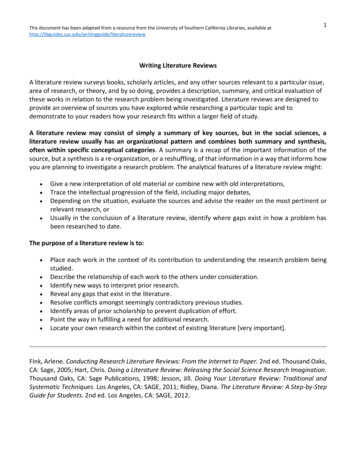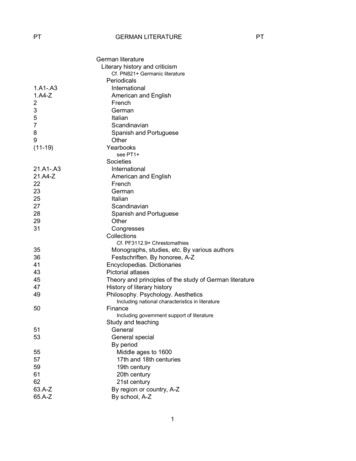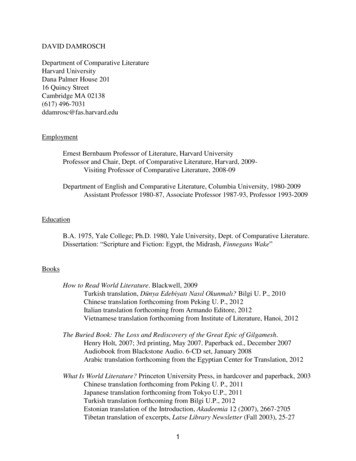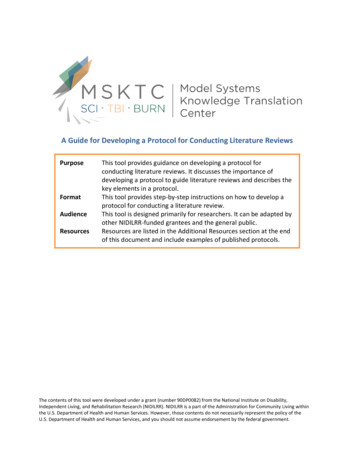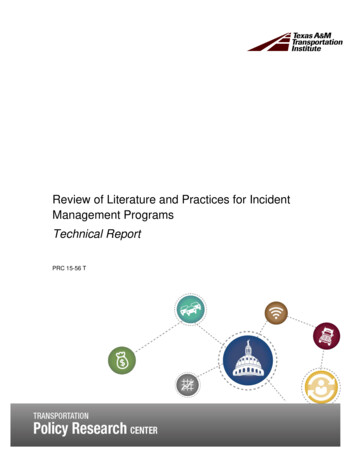
Transcription
Review of Literature and Practices for IncidentManagement ProgramsTechnical ReportPRC 15-56 T
Review of Literature and Practices for IncidentManagement ProgramsTexas A&M Transportation InstitutePRC 15-56 TJune 2016AuthorsTim LomaxLauren Simcic2
Table of ContentsList of Tables . 4List of Acronyms . 5Review of Literature and Practices for Incident Management Programs . 6The Federal Highway Administration: Incident Management Key Strategies . 7Performance Measures and Targets . 10Key Rapid Clearance Strategy Elements . 12Unified Incident Command . 12Standardized Operations and Response Practices . 12Developing the Framework of a Successful TIM Program. 13More Coordinated and Timely Use of Technology. 13Availability of Transportation Incident Responders . 13Joint Accredited Incident Management Training . 13Clearance Performance Goals . 14Performance Measures . 14Move-It Laws and Policies . 15Authority Removal Laws . 15Quick Clearance/Open Roads Policy . 15Law Enforcement and Quick Clearance Performance Goals . 15Traffic Control by On-Site Traffic Management Teams. 16Medical Examiner Procedures and Policies . 16Towing Industry Issues . 16Emergency Responder Designations . 17Attributes and Experiences from Incident Management Programs . 18Incident Management Program Operating Agencies . 18Funding and Contracting Partnerships . 18Implementation of Specific Strategies . 21Service Area Coverage and Staffing . 23Program Operating Hours . 23Transportation Operations Performance Data and Meetings . 25Program Costs and Benefits . 28Conclusions . 30References . 31Appendix A: Summary of 2013 Traffic Incident Management Self-Assessment Results . 37Appendix B: Federal Highway Administration 2009 Traffic Incident Management,Self-Assessment Template Instruction Sheet and User Guide . 41Appendix C: 2015 Traffic Incident Management Self-Assessment . 463
List of TablesTable 1. Incident Performance Measures. 14Table 2. Incident Management Program Operating Agencies. . 19Table 3. Funding and Contracting Partnerships. . 20Table 4. Implementation of Specific Strategies. . 22Table 5. Service Area Coverage and Staffing. . 24Table 6. Program Operating Hours. . 25Table 7. Transportation Operations Performance Data and Meetings. . 26Table 8. Program Costs and Benefits. . 294
List of MSATMCTxDOTWATIMCoWSDOTWSPAustin Police DepartmentArizona Traffic Management and OperationsComputer-aided dispatchCentral Texas Regional Mobility AuthorityDepartment of transportationDepartment of Public SafetyFederal Highway AdministrationHarris County Toll Road AuthorityHighway Emergency Response OperatorsIncident management planIncident response teamMaricopa County Association of GovernmentsHarris County Motorist Assistance ProgramDallas-Fort Worth Mobility Assistance Patrol ProgramMemorandum of understandingMetropolitan planning organizationManual on Uniform Traffic Control DevicesNational Incident Management SystemNational Traffic Incident Management CoalitionNorth Texas Tollway AuthorityNational Unified GoalPlanning Time IndexStrategic Highway Research Program 2Traffic incident managementTraffic Incident Management Self-AssessmentTraffic management centerTexas Department of TransportationWashington Traffic Incident Management CoalitionWashington State Department of TransportationWashington State Patrol5
Review of Literature and Practices for Incident ManagementProgramsThe project team examined project evaluations, best practice summaries, and synthesisdocuments, and derived a summary of key elements of programs to speed the time to find andclear stalled vehicles and crashes from freeway shoulders and main lanes. The key questionsabout these programs (known generically as incident management) include the following: Who operates the program? What are the key equipment and procedural elements? How is the program funded? How much of the road network is covered and for what times/days? What are the incident management program institutional arrangements andinterjurisdictional operating practice memoranda? What are the benefits and costs?This literature review summarizes key practice elements that describe a comprehensive trafficincident management (TIM) program and then compares those characteristics to the significantTexas programs. The goal is to describe the current state of the practice on a few key items as thebeginning point of discussion about any additional public policy guidance or legislation needs.6
The Federal Highway Administration: Incident ManagementKey StrategiesThe Federal Highway Administration (FHWA) analyzed the important elements of TIMprograms and determined several characteristics that are associated with a high-performingprogram. These are not all the needed elements, and not all of these elements are absolutelyrequired. Accomplishing all of these aspects does not ensure that a program will provide all theservices and performance that an area could desire, but the following list of best practiceelements provides a good return on the operations investment (1): Agency relations—These elements make the point that TIM is not simply a technologyprogram. Agency relations include:o Routine, periodic TIM team meetings to encourage ongoing dialogue among TIMresponders, increasing awareness of priorities and roles.o Joint agency/jurisdictional protocols and joint traffic/emergency management centersto formalize agency relations and respective roles in TIM and to demonstratecommitment through common resource/facility investments. Training—In particular, this makes the point that interagency training is the way to notonly improve performance but also to enhance agency relations. Training includes:o National TIM and information clearinghouses/communities of practice to supportinformation exchange among various response agencies involved in TIM regardingnational best practices.o Local multidisciplinary TIM training and associated tabletop exercises/scenarios andafter-action reviews/debriefings to encourage joint and effective training amongresponders and improved local TIM operations.o Multidisciplinary TIM response plan/operating procedures to formalize recommendedactions in support of future TIM training efforts, enhanced responder competency,and consistent operations.o TIM personnel certifications/training requirements to support enhanced TIMresponder competency and consistent operations. Communications—Incident reviews have consistently shown great benefits from betterinteragency communications throughout an incident. Communications includes:o A common mutual-aid frequency/channel, alternative communications devices,wireless information networks, and an associated standardized communicationsterminology/protocol to enhance en-route and on-scene communications amongresponders from different agencies.7
o A mobile unified communications vehicle to enhance en-route/on-scenecommunications among responders from different agencies for major incidents andemergencies. Technology—Increasing the opportunity for all agencies to have the same equipmentreduces some of the most vexing technology issues; it is important that state policy bealigned with this goal to the extent possible. Technology includes:o An expedited standards development process and policies requiring state standardprocurement to encourage the acquisition of interoperable equipment and technology,reduce purchasing time, and minimize capital and maintenance costs. Performance measurement—An important aspect of evaluation, improvement, andaccountability is a continuous monitoring and reporting system that covers safety andcongestion outcomes. A performance measurement process can be the beginning of theprocess of deciding how much, if any, change is needed. Performance measurementincludes:o National performance measurement guidance to lend consistency and consensus toTIM performance metrics at the state and program levels.o TIM self-assessment to support the identification of strengths and weaknesses and thedetermination of activities that can improve performance. (See Appendix A for acopy of the self-assessment results). Policies could mandate the annual completion ofthe self-assessment form and improve the information within the self-assessmentprocess.o A strong funding and performance link to ensure that TIM program effectiveness canbe demonstrated and adequate attention is given in project funding prioritization.o A multi-agency data exchange protocol to enhance data sharing and accessibility insupport of TIM performance measurement activities. Program resources and funding—Most of the resource issues are within an agency’scontrol; state, county, city, metropolitan planning organization (MPO), and othergovernmental groups could fund incident management programs. In many places, thelimitations relate to historic operations funding allocations and an expectation that allfunding will go toward road building. Certainly there is enough information to describethe high cost-effectiveness of incident management programs that reduce congestion,improve safety, and enhance customer service. Program resources and funding include:o Dedicated, ongoing funding, guidelines for federal/state funding sources, MPOpartnerships, and an associated TIM strategic plan to ensure ongoing access toprogram resources and funding.8
o Efficient/effective TIM resource management to encourage optimum use of existingresources.o Executive outreach materials/events to ensure that the effectiveness of TIM programsis adequately demonstrated to decision makers and that TIM programs subsequentlyreceive adequate attention in prioritization of projects for funding.9
Performance Measures and TargetsIf the FHWA key strategies are examined, progress on agency change could begin withperformance measurement. All regions focus on responder safety as a primary objective ofenhanced incident management programs. A few regions have established targets for TIMperformance that specify response and/or clearance times for all incidents within a specified timeframe. A goal of clearing all incidents within 90 or 120 minutes is typical. Such goals can behighly controversial and even political if they are applied to all incidents; for example, even awell-done hazardous materials spill could take much longer than 90 minutes to clear. The goalsencourage multi-agency reviews of the incident processes to see where procedural changes orcoordination of activities at the incident can reduce clearance time (2).The key performance measures should include agency action measures, as well as congestionand safety outcome measures. Incident management or service patrol programs should gatherdata about the services that each service patrol operator delivers and the congestion and safetyoutcomes. In this manner, statistical analysis can be used to develop trends and comparisons.When tracked properly and linked with the traffic management center and first respondercomputer-aided dispatch (CAD) systems, statistics should also be kept about: Types and number of services rendered. First responders struck during incident scene activity. Response time. Incident clearance time. Incident duration time. Lane blockages. Number and severity of incidents. Congestion and delay hours.These data will help identify the program performance and its impact on quick clearance times,safety, and congestion (3).Among other measurements, the Washington State Department of Transportation (WSDOT)collects the following data: Number of incidents by geographical area. Response times. Incident clearance times. Incident duration goal.10
Volume of instant tow deployments in each area. Number of major incident tow team activations. Success rate in the 90-minute clearance requirement.Data are shared between agencies so that all groups use the same information and data costs areminimized (4).11
Key Rapid Clearance Strategy ElementsNational guidance on creating an excellent TIM program points to key elements that successfuloperations have in common. These are a combination of policies, operating practices, andagreements between agencies and typically focus on freeways rather than streets, due to thehigher traffic volume on freeways and the potential for crashes to be moved from major streets todriveways or side streets. The programs usually require alterations in the practices of individualagencies toward more engagement and interaction. The strategies are designed to accomplishbroad outcome types of goals (such as reduced crashes and travel time) with specific actions,practices, and policies that operating agencies and on-scene personnel can understand andaccomplish.In most cases, any incident management program review mentions budget concerns. However,incident management program costs are relatively small in comparison to most state agencybudgets. This section describes the key elements from the National Traffic Incident ManagementCoalition (NTIMC) report on achieving the National Unified Goal (NUG) (5) and the TrafficIncident Management Gap Analysis Primer (6).Unified Incident CommandUnified incident command and incident command systems improve command, control, andcoordination of an emergency response. When complex incident scenes involve multipleagencies or political jurisdictions, it is important that personnel at all levels understand wherecontrol and scene management are directed.Standardized Operations and Response PracticesNTIMC held stakeholder listening sessions in 2006 (5), producing these and other suggestionsfor best practice guidelines. The report promotes “proper incident investigation and datacollection” during clearance of commercial vehicles “to ensure that the carrier will be able tosubstantiate insurance claims.” Towing and recovery operations can be improved through vettingof qualified towers, combined with quick clearance incentives. WSDOT, the GeorgiaDepartment of Transportation, and the Florida Toll Road Authority’s incentive clearanceprograms have proven successful. Additionally, the report (5) endorses: Improved traffic control at incident scenes. Streamlined procedures for investigating fatal incidents. Training more state and local officials in traffic incident investigations. Training responders to distinguish between hazmat incidents and nonhazardous spills.12
Developing the Framework of a Successful TIM ProgramThe TIM gap analysis framework (6) describes a process to customize programs to fit the needsof each community by considering three elements. The framework uses the principle that there isno single one-size-fits-all incident management program, but there are important considerations.A plan formed around these three key elements might look like the strategic highway safetyplans that are being developed; they would be a documentation of the program investments anddescribe a dynamic plan that adjusts to resource allocations and policy directions. The threeelements are: Strategic—a framework for multi-agency planning, programming, and evaluation neededto support on-scene operations, including strategic plans, policies, and training. Tactical—the tools and technologies for traffic management and interagencycommunication. Support programs—communication systems, data and video sharing, and travelerinformation.More Coordinated and Timely Use of TechnologyTechnology can be used more efficiently in the areas of responder communication, travelerinformation, and incident investigations. Responder communication can be improved withintegration of CAD data into the traffic information system, the formation of “regional wirelessinteragency emergency information exchange networks,” and next-generation 9-1-1 systems.Automating traveler information systems (for example, to control changeable message signs) canallow personnel to focus on tasks requiring human input.Incident investigations were improved with the use of survey equipment in the 1990s; today,there is some reluctance to move away from that equipment, even though digital photos can dothe same job as accurately and much faster, creating less congestion and fewer secondaryincidents. The Indiana State Police, for example, estimate that digital photogrammetry savedmore than 90 minutes over the use of the total station surveying technique at crash scenes (7).Availability of Transportation Incident RespondersTransportation responders are frequently unavailable for traffic control during non-businesshours, even though their help is especially useful at night. Budgetary constraints are typical, buthaving an overnight response force in large regions with a 24-hour traffic management center isimportant.Joint Accredited Incident Management TrainingInterdisciplinary cross-training should involve towing companies, law enforcement personnel,fire departments, emergency medical services, and transportation agencies from all levels of13
government. This training should improve the safety of all responders by better informingtransportation and towing professionals about incident command systems, including the NationalIncident Management System, and to train other responders in traffic-related operations. FHWA,the American Traffic Safety Services Association, and the Towing Recovery Association ofAmerica provide resources for TIM training and certification. These resources includeworkshops on TIM and temporary traffic control, and a vehicle identification guide to helpresponders identify the appropriate towing and recovery vehicles at an incident scene.Clearance Performance GoalsClearance goals should be universal in all U.S. cities and states, but they are not. If goals includeboth adequate measurement resources and performance metrics that all parties agree to, they canfocus the efforts of many agencies and the private sector to improve TIM. There are variations inthe challenges in each city or region; goals should be relevant to that jurisdiction, and the key isto develop information for field personnel.The following are examples of states’ chosen clearance times: California, Washington State, and Florida: 90-minute incident clearance targets. Utah: 20 minutes for fender-benders, 60 for injury crashes, and 90 for fatalities. Idaho: 30-, 60-, or 120-minute maximum clearance times, based on incident severity.Performance MeasuresFHWA is developing performance measures that address the mandates in the Moving Ahead forProgress in the 21st Century Act (MAP-21) legislation. While these measures are not yetavailable, Table 1 provides a few good measures of agency activity and congestion improvementperformance. These measures were developed in the Guide to Effective Freeway PerformanceMeasurement (published by the National Cooperative Highway Research Program) (8) andStrategic Highway Research Program Report L03, Analytical Procedures for Determining theImpacts of Reliability Mitigation Strategies (9).Table 1. Incident Performance Measures.Performance MeasureResponder safetyResponse timeIncident durationPlanning Time Index (PTI)DefinitionResponders struck by vehicles during incident scene activityTime from notification of an incident to arrival on sceneTime from notification of an incident to when all evidence of thescene has been removed95th percentile travel time divided by low-volume travel time; a PTIof 1.80 indicates a traveler should allow 36 minutes for a 20-minuteuncongested tripSource: (3, 8, 9)14UnitsNumberMinutesMinutesNone(unitless)
Move-It Laws and PoliciesMove-It laws encourage or require drivers that are involved in a non-injury crash to movecrashed vehicles and debris out of the roadway if they can do so safely. These laws may alsoempower responders to move vehicles and debris off the roadway (4). The I-95 CorridorCoalition has issued a model Move-It law, which protects drivers and responders from liabilityas they move cars and cargo, while excusing failure to perform these actions if drivers orresponders identify risk of further damage or injury (10).Texas’ Steer It, Clear It law was enacted in 2001 (Section 550.022 of the Texas TransportationCode) (11) to require motorists to move crashed vehicles if they can be safely driven from thefreeway main lane, ramp, shoulder, median, or area adjacent to the freeway. The law states thatvehicles shall be moved as soon as possible to a location on the frontage road, nearest crossstreet, or other suitable location to minimize interference with existing freeway traffic flow. Andyet, many drivers remain under the mistaken impression that they must wait for police officersbefore their vehicles can be moved.Authority Removal LawsAuthority removal laws provide authorization to a set of designated public agencies (usuallyincluding state, county, and local law enforcement or the state department of transportation[DOT]) to remove damaged or disabled vehicles and/or spilled cargo that are determined to be ahazard. Driver and authority removal responsibilities are often defined within the same statute: ifthe driver is unwilling or unable to remove the vehicle or cargo from the roadway, designatedauthorities may require or perform removal without consent of the owner (10). TexasTransportation Code 545.3051 provides removal authority to staff of law enforcement,metropolitan rapid transit authorities, and regional transportation authorities if the spilled cargoor personal property “blocks the roadway or endangers public safety” (12).Quick Clearance/Open Roads PolicyOpen roads policies are a formal statement of agency goals and the partnerships needed toremove vehicles, cargo, and debris from roadways. Goals for incident clearance time often startwith the arrival of the first responding officer and are designed to restore safe and smooth trafficflow after crashes and other incidents (13).Law Enforcement and Quick Clearance Performance GoalsRelationships between DOTs and state patrols can be strengthened with agreements on quickclearance performance goals that recognize the concerns about crime investigation and publicsafety (10). Some examples of agreements between state DOTs and law enforcement are:15
Florida and Washington—The state patrol has fully endorsed a 90-minute clearance goal. California—The state DOT’s 90-minute clearance goal is not an official performancemeasure for the California Highway Patrol, though the agency has agreed to embrace thistarget.Traffic Control by On-Site Traffic Management TeamsEffective traffic control by on-site traffic management teams can reduce congestion and theoccurrence of secondary incidents. These activities can be enhanced by warning systems thatalert drivers to incidents or the associated congestion (3).Medical Examiner Procedures and PoliciesRather than waiting for a medical examiner to arrive at a fatal traffic incident, some states haveattempted to institute legislation (or informal agreements) that allow for quicker clearance.California has seen mixed results in pursuing these policies; on the state level, the proposedlegislation failed, but Los Angeles County has adopted protocols that facilitate rapid clearance offatal injuries. One proposed compromise is to move a vehicle containing a fatally injuredpassenger off the road until the medical examiner can perform an investigation.Towing Industry IssuesRotation lists are used in many regions to provide equitable business opportunities to towingoperators. Cities and regions typically have response time goals around 20 or 30 minutes andallow operators to opt out of a tow if they are unable to respond. Incentive pricing is infrequentlyused to solve towing delays. Florida’s approach, mentioned previously, involves both incentivesfor quick clearance and pricing disincentives for slow performance. The result is averageclearance times below 90 minutes in two studied locations in Florida. Financial supplements arealso provided that tow companies can use for equipment and training (10).The Houston SAFEClear towing program is an effective public-private partnership. This City ofHouston–operated program holds towers accountable to a response time goal by assigning eachsection of freeway to a towing operator. The operator is responsible for identifying the resourcesneeded to meet a standard of 90 percent of responses within 6 minutes. This aggressive goal hasbeen met almost every month of operation since the program began in 2005 and continuouslysince 2009. In 2013, almost 98 percent of responses were within the 6-minute standard (14). Theprogram’s success is a combination of this specific accountability element—an operator isresponsible for every incident—and the city’s willingness to pay the towing companies forrapidly removing stalled and crashed vehicles, rather than investing in its own personnel andequipment fleet.16
Emergency Responder DesignationsTransportation agencies and private-sector responders (including towing companies) should berecognized as part of the first responder team, with rapid notification and safe scene accessprovided. Oregon treats transportation agencies as emergency responders; Oregon Department ofTransportation traffic incident response teams (IRTs) are stationed in specific corridors, and theOregon Department of Transportation and the state patrol are notified of incidents using a sharedCAD system. Texas Transportation Code Section 547.305 (15) allows tow trucks to use lightingrestricted to emergency vehicles. In most Texas cities, tow trucks are second responders; they arecalled by law enforcement after some initial scene investigation, slowing the crash or stallclearance.17
Attributes and Experiences from Incident ManagementProgramsThe literature and experience reveal that most large Texas cities know about and use many of theelements in the standard, FHWA-guidance incident management program. All of the equipmentand technology may not be present, but they could be obtained if a more extensive andaggressive program was developed. While incident management programs are not ubiquitous,the limitations are typically related to lack of budget allocation for operations programs and lackof institutional support.This section provides an overview of major program components for the Texas incidentmanagement systems and three examples of systems from outside Texas. More information onsystems and practices from other states can be found on the website for NTIMC(http://ntimc.transportation.org). Kansas City Scout, Arizona Traffic Management andOperations (AZTech), and the Washington Traffic Incident Management Coalition (WATIMCo)are considered among the best management pr
incident management (TIM) program and then compares those characteristics to the significant . process of deciding how much, if any, change is needed. Performance measurement . Unified incident command and incident command systems improve command, control, and coordination of an emergency response. When complex incident scenes involve multiple

